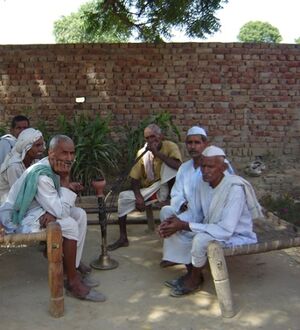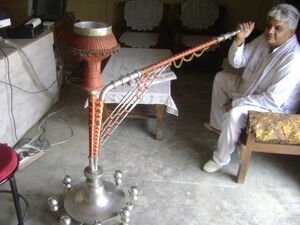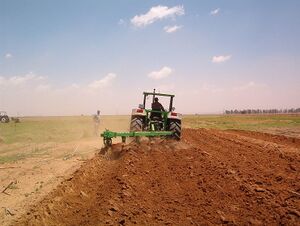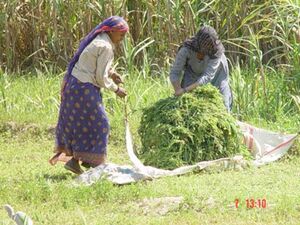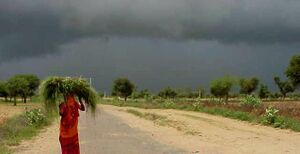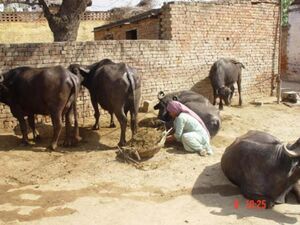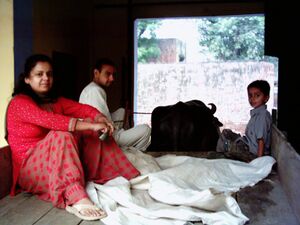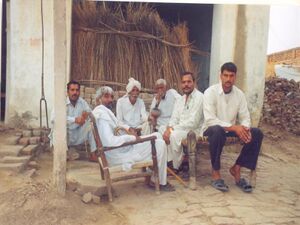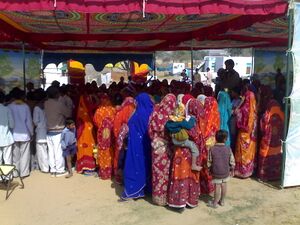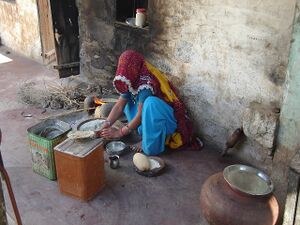Life and culture
The Life and culture of Jats is full of diversity and approaches most closely to that ascribed to the traditional Aryan colonists of India. The Jat lifestyle was designed to foster a martial spirit. When they lost their kingdom, states and social eminence, retired to the country-side controlling and tilling the land with their swords girded round their waists. They would draw the sword out of the scabbard at the command of their panchayat to fight with the invaders. Jats are the best cultivators as well as brave and ready fighters.
Youth especially Jats are more inclined to sports like Kabbadi and kushti. There is tradition of Akhadas and it has given various national and international level wrestlers. In these times Kushti and Kabaddi are sole source of entertainment in villages on occasions like Holi and Fagun.
Leaving some Jats who are in service or in active politics or are in noble professions like legal , medical or engineering etc., most of the Jats are engaged in cultivation. They are born in villages and after primary education, acquaint themselves with agriculture and by the age of sixteen , they completely take over to this vocation with their parents. After obtaining maturity, young Jats develop fancy to possess better breed and healthy animals. Till fifty years back, he used to ride on good horse whom he loved most and took pride in horse riding. By the change of animal era to machinery period, Jats too have changes over to tractors and tillers in place of bullocks and jeep instead of horse. However a Jat in a village or on his farm cannot do without one or two buffaloes because without milk, curd , Ghee(butter) and Chaach(cream separated curd), his daily diet remains incomplete. Only five decades before , if a stranger requested a Jat for a glass of water to quench his thirst, he was supplied with a glass of Lassi (diluted curd mixed with sugar). He did not mind if some one extracted one or two sugar-canes, cucumbers or watermelons from his field to feed oneself for taste. It was customary for a Jat to offer a quarter kilo Gud (Indigenous substitute from sugar) to one who happened to be sitting in the Kolowah at the time of its preparation.[1]
Professions
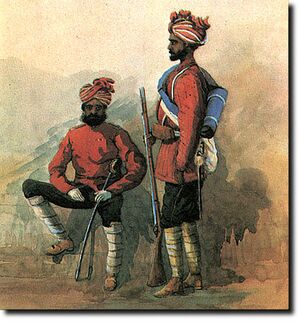
Today we find Jats in all professions. Some of the leading jats in these professions are mentioned in the following links:
• The Industrialists and Businessmen
The Jats, like some South Asians, are mostly landlords; however, they are also found in many other professions. Traditionally they have formed part of the land & gentry and ruling upper classes. A large number of Jats belong to the political classes and have produced many powerful leaders, including the 7th Prime Minister of India, Prime Minister Choudhary Charan Singh. Moreover, there have been many Jat Kings and warriors throughout history. A large number of Jats serve in the Indian Army, including the Jat Regiment, Rajputana Rifles, Sikh Regiment and the Grenadiers and have won many of the highest military awards for gallantry and bravery. Jats also serve in the Pakistan Army especially in the Punjab Regiment, where they have also been highly decorated.
The Jat regions in India are among the most prosperous on a per-capita basis (Haryana, Punjab, and Gujarat are among the wealthiest of Indian states).
A Jat generally goes for only two professions, handed down by his ancestors, agriculture or soldiering, and excels in both. A Jat may starve but will seldom take up a profession involving menial labour for another person. As soldiers they are fearless and loyal but sensitive, and need careful handling and good leadership. As farmers they are very industrious and both men and women work hard on their land. They are very fond and proud of their cattle, which are amongst the finest breed in the world. Jats meet their simple needs from what they produce and are, therefore, self-reliant. This has had two effects. On one hand, they have managed to live in tact for centuries around Delhi, the capital of India, and could never be coerced in to changing their form or character inspite of numerous changes of governments with different ideologies and religions. On the other hand it has hampered their progress in modern times in educational and technical fields, because they stuck to their land.
Jats in agriculture
Majority of the Jats are born in villages and after primary education, acquaint themselves with agriculture and by the age of sixteen, they completely take over to the traditional profession of agriculture with their parents. After obtaining maturity, young Jats develop fancy to possess better breed and healthy animals. Till about fifty years back, they used to ride on a good horse that they loved most and took pride in horse riding. Majority of Jats used to keep good camel in Rajasthan desert area for riding. By the change of animal era to machinery, Jats too have changed over to tractors and tillers in place of bullocks and Jeep instead of horse or camel.
Green revolution
The green revolution of agriculture in India led to significant increases in agricultural production between the 1940s and 1960s. This transformation occurred as the result of programs of agricultural research, extension, and infrastructure development with the hard work of Jat farmers, especially in the areas inhabited by Jats. The green revolution has brought the Jats a lot of money. It is the result of green revolution that the Jat regions in India are among the most prosperous on a per-capita basis (Haryana, Punjab, and Gujarat are among the wealthiest of Indian states).
The Green Revolution also brought changes in lifestyle of Jat farmers. Aspirations increased – there was demand for better education for children, better housing and better consumer goods. The traditional joint family system is being gradually replaced by the nuclear family. [5]
Politics also changed. There was a gradual shift of power from the urban elite to the rural elite. The Jats became the dominant political group and as a result, development of agriculture became the top priority of every successive government. Supply of agricultural inputs at cheaper rates became a core demand. In order to relieve farmers from money lenders, co-operative societies and commercial banks were established in large numbers to provide agricultural credit to the farming community. As agricultural became modernised, electricity for agricultural purpose was required at cheap rates for long hours. Similarly, fertilizers and pesticides were also required to be supplied at cheap rates. Thus, successive governments responded by granting subsidies. [
Love for land
Jats adorn above all other things, the land which they cultivate. His love and respect for the soil is no less than his own mother. In case, little of his land is usurped by some one, even by his own cousin, he will prefer to die in a quarrel than to allow the other to usurp his land. His love for land spells no bound.
Jats love gardens. A chaupal is a necessity in every Jat village. They are loyal to the country of their habitation.
Love for animals
A Jat in a village or on his farm cannot do without one or two buffaloes or cows because without milk (दूध), curd (दही), ghee (घी) and chhaach (छाछ) (cream separated curd), his daily diet remains incomplete. chhaach (छाछ) is distributed free to the needy neighbours. During period about five decades back, if a stranger traveler requested a Jat for a glass of water to quench his thirst, he was offered with a glass of lassi (diluted curd mixed with sugar and spices). He did not mind if some one extracted one or two sugar canes or watermelons from his field to feed oneself for taste. It was customary for a Jat to offer a quarter kilo gur to one who happened to be sitting in the kolowh at the time of preparation.
Hard working people
Jats are the backbone of cultivation and have added to the produce of food grains and sugarcane to a great extent. They have proved to be the best farmers. And work very hard with the soil. A young Jat of India, energetic as he is, labours hard or rather very hard in his vocation at the time of work and recreates fully at the leisure time. He enjoys sound sleep after hard work. At the age of 40-45 his sons replace him in his hard work. He then enjoys cool breeze under a tree in his gher (cattle shed) or in Chaupal with hooka (hubble bubble) with others. At the age of sixty he is adorned as Chaudhary (village headman) and as a right commands respect from the whole of village folk. In past times, a Chaudhary proved to be an intelligent and impartial judge in deciding the petty conflicts in the village.
Jat woman
A traditional Jat woman’s beauty of character is that she always works shoulder to shoulder with her husband. Lighter duties of maintaining the animals are left to them while the males do heavy work. She looks after the home and males look after outside the home matters. A Jat woman gets up early in the morning; she milks the buffaloes/cows and gives fodder to them and other animals. She sweeps the house and afterwards she churns the curd. She brings water from village well. Then prepares breakfast and takes it to the field for husband. Again she prepares lunch and once more reaches the field to serve it to the males working at the field. On coming back home she is busy with her charkha to spin yarn out of cotton or wool. Thus at home she works for the clothing need of the family. Many of the ladies come to commonplace with charkha and without wasting time, make chitchats and enjoy the society. Mahatma Gandhi, who used it as a tool to gain independence, realized the importance of charkha in the Indian economy. In evening she prepares dinner and after feeding every member of the family, she also takes her food after which she prepares large sized glasses of milk for males and females. Even after so much of labour, she does not feel dizzy and does not lack to please her husband. All the day round busy keeps her active and healthy to keep doctors away. She seldom needs a nursing home for delivery. Her only demand is heavy silver or the gold ornaments.
Reference
- Mangal sen Jindal (1992): History of Origin of Some Clans in India (with special Reference to Jats), Sarup & Sons, 4378/4B, Ansari Road, Darya Ganj, New Delhi-110002 ISBN 81-85431-08-6
Author: Laxman Burdak लक्ष्मण बुरड़क
References
- ↑ Mangal Sen Jindal (1992): History of Origin of Some Clans in India (with special Reference to Jats), Publisher - Sarup & Sons, 4378/4B, Ansari Road, Darya Ganj, New Delhi-110002, ISBN 81-85431-08-6, p. 64
